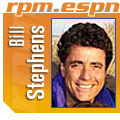 If there's one particular source of confusion for the average newcomer to NHRA POWERade drag racing which causes a steady stream of bewilderment, it's the concept of a holeshot. How can a driver win a race with a slower elapsed time than his opponent?
If there's one particular source of confusion for the average newcomer to NHRA POWERade drag racing which causes a steady stream of bewilderment, it's the concept of a holeshot. How can a driver win a race with a slower elapsed time than his opponent?
It's a question that veteran drag racers, tuners, and yes, ESPN announcers get all the time. Let's try to clear up the confusion once and for all.
It's important to remember that each lane is timed individually. Each driver will be timed strictly from the instant he launches from the starting line until he crosses the finish line. And in order to win on a holeshot, a driver's reaction time must be quicker than the RT of his opponent.
For instance, if a driver has a .005 reaction time, and his opponent has a .500 reaction time, the first driver has quite an advantage as the race begins, so much so that he can actually run a slower elapsed time and still reach the finish line first. Simply stated, get enough of a head start on your opponent when the Christmas Tree turns green and you'll still win the round -- even if you ran a slower time.
Here's an overdrawn comparison: Remember the classic Aesop fable, "The Tortoise and the Hare?" The hare sat down and took a nap during the race while the tortoise trudged steadily along. When the hare finally woke up, the tortoise was so far ahead that despite running much faster than the turtle, the rabbit was unable to catch up in time.
Here's another one. Imagine you and a friend were going to travel from Chicago to New York. You were going to make the trip on a jet and he was going to go by train. The jet would obviously be much faster than the train but let's say he was leaving at 9 a.m. and you were leaving 12 hours later at 9 p.m. With such a huge head start, his train would arrive in New York long before your jet landed that evening. Which vehicle traveled faster? The jet. But who got there first? The train, because of its head start.
Of course, in drag racing the increments of time are much smaller -- tenths, hundredths, and thousandths of a second. But the principle we're looking at remains the same. The driver who gets away first can actually run a slower e.t. and still get the winlight -- a holeshot victory. And with round victories on the line, taking the holeshot is arguably just as important as any other element of a run down the quarter-mile.
Hope that clears up the confusion.
Bill Stephens covers the NHRA for ESPN and ESPN.com.
ESPN and ESPN2 will feature the special informational program during the networks' regular coverage of the NHRA event at Denver: on ESPN Saturday, July 19 from 7-9 p.m. ET; and Sunday from 2:30-3:30 p.m. live on ESPN and 6-9 p.m. on ESPN2. NHRA2Day, ESPN2's weekly news show, will also continue the Information Dragway theme Sunday at 11 a.m. ESPN Radio's RPM Now with host John Kernan, Friday from 8-10 p.m. (check local listings), will feature live driver interviews.
